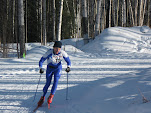Another Birkie Weather Bust
This winter has been most mild in the upper Midwest, and in the weeks leading up to the race only a few inches of snow covered the ground. All was set until Wednesday the 21st (3 days before the race), when temperatures hit 51 degrees, which effectively ruined the trails on the 2nd half of the course. Rather than cancelling, the race directors decided that there would be enough snow have a shortened version on the 23k Korteloppet (literally “short race”) course.
How inconvenient, the truth.
I’ve done two Birkies, and was hoping to make the third one a charm. I completely revamped my race schedule, and decided to delay gratification until late February and March. It was hard to set aside a couple of the races, but had some great marathon-type workouts on my own. Although last March’s marathon crescendo may be hard to beat, February’s training was perhaps the best string I’ve had 14 or 15 years. Everything felt perfect, and I was ready to take on the crowds and trails at the Birkie.
On Wednesday afternoon I was wrapping up my final half day of work before travel, when I got an email from my friends—had I not checked, I may well have gone. But after thinking about it for a few hours, I decided to cancel this year. The appeal was the full 51k my goal was just to get through that first 23k when the trail would be packed with both Korteloppet and Birkie racers. The real fun would begin after the Korteloppet finished at County Road OO, aka the Double O.
Now with a little time on my hands I went back to the Birkie history page, http://63.134.240.83/?page=1065&mediaid=6 to look at weather related impacts. The Birkie was established in 1973, and the scheduled distance has ranged from 50 to 55 km since then. The first indication of a weather problem was in 1981, when warm weather and rain forced a re-route of the elite race: racers did a 48k loop; course, and the citizen’s race was held two weeks later after an early March snowfall.
In 1983, 84, 85, and 87 the course was shortened to 48k to 50k due to low snow cover at the start area, but the race went on otherwise as planned. Then came the 90s.
In 1991, the race was only 46k, due to lack of snow in the open areas. Ironically 1996 was a long and bitter winter in the upper Midwest, but temperatures on race day exceeded 50 degrees, making for some very slow skiing. In 1998, much like this year, they had to cut the race in half, to 25k. The bottom fell out in 2000, when the race was cancelled outright due to lack of snow. Things looked bleak in 2002, when there was little or no snow on the trail until just four days before the race, when a miracle dump of 8 inches fell on the trail, allowing for a 46k race.
It would be interesting to look at snow cover data from the 1950s and 60s, but the trend from the early 80s on certainly seems to be on of less snow, warm temperatures, and drastically foreshortened courses (one cancellation and two half-length courses from 1998 to 2007).
Well, maybe next year. Meanwhile, I’m going to enjoy the rest of my birthday in 30-40 below temps in Fairbanks, while I plan for Tour of Anchorage, the Sonot Kazhoot, and hopefully another marathon in March.


1 Comments:
Frustrating, but you made a wise choice, I think. Climate data suggests average winter temperatures may have "only" warmed a degree or so over recent decades for the region. But that difference, sadly, is the difference between somewhat reliable conditions for the Birkie and a crapshoot. Our "winter" with ski-able snow here in central NH will likely be about 3 weeks long this year. Hard to justify specific ski training and racing, much less spending $$$ on equipment, for such an unpredictable seasonal pasttime.
Sigh... I'm enjoying the snow a great deal, though -- while we have it.
Grambo
Post a Comment
Subscribe to Post Comments [Atom]
<< Home